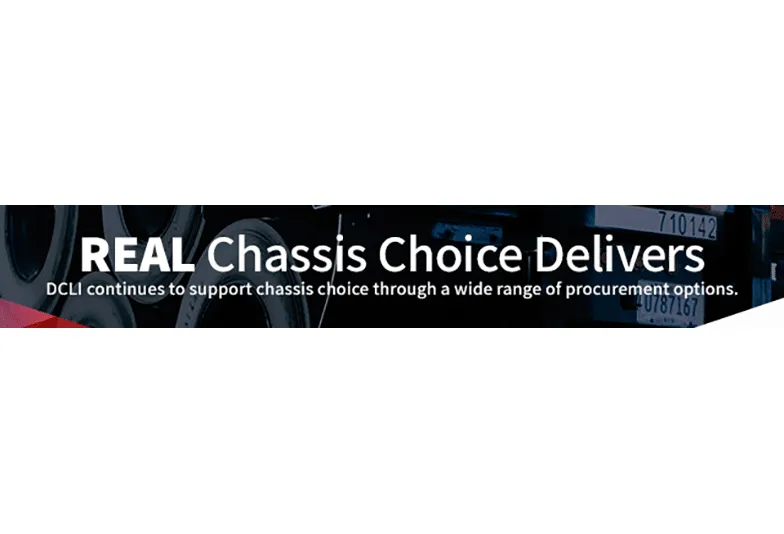Corporate Headquarters
3525 Whitehall Park Drive, Suite 400, Charlotte, North Carolina 28273
Phone: (704) 594-3800

The primary focus of the Federal Maritime Commission’s (FMC) February 2024 ruling in the chassis case was on the OCEMA-managed Consolidated Chassis Management (CCM) pools and how they were run. Most of those pools have now closed and in the case of the Southeast the pool has transitioned to a new model without the multi-contributor or associated billing “choice” structure that was at the heart of the IMCC lawsuit. In the meantime, the market has been driving significant changes, including greater use of trucker- or BCO-controlled chassis to supplement the traditional daily rental pools.
In other words, the market has spoken and truckers and BCOs have a wide variety of options to choose from: competitive chassis pools like our DCLP, trucker owned or leased wheels, reservation-based models, and any other number of chassis procurement options locally, regionally, and nationally. In fact, our data shows that one of every two chassis moves across the country for the ocean carriers we support is now performed by a trucker-controlled (leased, owned, or alternative pool) chassis, demonstrating that REAL choice exists.
Knowing that the FMC ruling might cause some confusion around how it truly affects chassis procurement, we have prepared the following list of questions and answers. The FMC’s order covers four markets: Chicago, Memphis, LA/Long Beach, and Savannah. We have split this Q&A into those four markets in order to address the questions most pertinent to each. Please contact customerservice@dcli.com if you have any questions that aren’t addressed here – we’ll be happy to offer answers and add those Q&As to this page.
Chicago Market:
Q: What if I don’t want to use the chassis that’s under my box at a wheeled rail ramp?
A: Pool chassis have historically been used to support wheeled or hybrid operations at rail ramps. You are welcome to use any chassis that you’d like to move a box at the rail ramp. If the box is already mounted to a chassis, but you prefer to use a different one, you will have to coordinate with the local rail ramp to have the box flipped to your preferred chassis, which will be subject to its flip practices and rates. That has been, and will continue to be, your choice.
Q: Will gate edits still be allowed and prevent me from using whichever chassis I choose at rail ramps?
A: Gate edits are a control for on-terminal chassis inventory and do not impede the ability for you to use your own chassis or a chassis sourced from any off-terminal supplier. These edits are designed to protect the inventory that has been established at a rail ramp by multiple on-terminal chassis suppliers to support inbound trains and cargo that require pre-wheeling (i.e., dismounting containers from trains straight to chassis for quicker staging/pickup). These supplies are essential to ensuring supply chain fluidity and efficiency at each of these wheeled or hybrid locations. Moreover, it is not an ocean carrier-created or ocean carrier-mandated practice and, as such, we do not expect it to be impacted by the FMC’s ruling. It is important for all stakeholders to understand and accept that container demand must continue to be met or exceeded by chassis supply at locations that need chassis for pre-wheeling so that our valued railroad partners can ensure neither their operations nor the larger supply chain network are put at risk. Note also that gate edits are never present at rail facilities that run wholly grounded operations in Chicago.
Memphis Market:
Q: What if I don’t want to use the chassis that’s under my box at a wheeled rail ramp?
A: Pool chassis have historically been used to support wheeled or hybrid operations at rail ramps. You are welcome to use any chassis that you’d like to move a box at the rail ramp. If the box is already mounted to a chassis, but you prefer to use a different one, you will have to coordinate with the local rail ramp to have the box flipped to your preferred chassis, which will be subject to its flip practices and rates. That has been, and will continue to be, your choice.
Q: Will gate edits still be allowed and prevent me from using whichever chassis I choose at rail ramps?
A: Gate edits are a control for on-terminal chassis inventory and do not impede the ability for you to use your own chassis or a chassis sourced from any off-terminal supplier. These edits are designed to protect the inventory that has been established at a rail ramp by multiple on-terminal chassis suppliers to support inbound trains and cargo that require pre-wheeling (i.e., dismounting containers from trains straight to chassis for quicker staging/pickup). These supplies are essential to ensuring supply chain fluidity and efficiency at each of these wheeled or hybrid locations. Moreover, it is not an ocean carrier-created or ocean carrier-mandated practice and, as such, we do not expect it to be impacted by the FMC’s ruling. It is important for all stakeholders to understand and accept that container demand must continue to be met or exceeded by chassis supply at locations that need chassis for pre-wheeling so that our valued railroad partners can ensure neither their operations nor the larger supply chain network are put at risk. Note also that gate edits are never present at rail facilities that run wholly grounded operations in Memphis.
LA/Long Beach Market
Q: Do I have to continue using Pool of Pools (PoP) chassis for container moves?
A: You have always been free to use whatever chassis is available in the PoP, which is fully interoperable across the fleets contributed by DCLI and TRAC. FlexiVan is in the process of exiting the PoP, but DCLI and TRAC are continuing to operate it as a two-party pool. You also continue to have the choice to bring your own wheels for any move, and we estimate that today four in every five chassis moves in the LA/Long Beach market are served by options outside of the PoP. DCLI provides a portfolio of solutions to help support your choices within this market, including our lease (DCLL), reserve (DCLR) and PoP options.
Q: What if I don’t want to use the chassis that’s under my box at a wheeled rail ramp or marine terminal?
A: Pool chassis have historically been used to support wheeled or hybrid operations at marine terminals and rail ramps. You are welcome to use any chassis that you’d like to move a box at the rail ramp or marine terminal. If the box is already mounted to a chassis, but you prefer to use a different one, you will have to coordinate with the local rail ramp or marine terminal to have the box flipped to your preferred chassis, which will be subject to its flip practices and rates. That has been, and will continue to be, your choice.
Savannah Market:
Q: What does this ruling mean for using an SACP 3.0 chassis?
A: DCLI does not currently operate its chassis pool, DCLP, in the Savannah market. For questions about the impact of this ruling on SACP 3.0 operations, we encourage you to reach out to Consolidated Chassis Management. Please note that this ruling has no impact on your access to DCLI’s term lease and private pool products within the Savannah, GA market. If you are interested in learning more, please contact sales@dcli.com
What About Gray Pools?
It’s notable that the FMC’s ruling did not address the initial request in the IMCC’s case to make nationwide gray pools mandatory. Our CEO, Lee Newitt, discussed this topic on the Let’s Talk Supply Chain podcast . Here’s an excerpt:
If you’d like to get updates on how regulatory changes may impact free market competition, choice, and fleet safety, fill out the form below to be added to our update list:
3525 Whitehall Park Drive, Suite 400, Charlotte, North Carolina 28273
Phone: (704) 594-3800
General
Email: DCLCHASPNW@dcli.com
General
Email: DCLCHASMTN@dcli.com
General
Email: DCLCHASGULF@dcli.com
Jacob Dixon
Title: Cleveland, Cincinnati, Columbus, Lousiville
Phone: 704-447-3241
Email: jacob.dixon@dcli.com
Paul Cochran
Title: Kansas City, St. Louis, Minneapolis, Omaha
Phone: 704-631-3207
Email: Paul.Cochran@dcli.com
General
Email: DCLCHASMWR@dcli.com
Lashana Davis
Title: Baltimore, Buffalo, Elizabeth, Philadelphia, Pittsburgh
Phone: 704-447-3225
Email: LaShana.Davis@dcli.com
General
Email: DCLCHASNER@dcli.com
Kim Erwin
Title: Memphis, Nashville, Huntsville, Tampa
Phone: 704-954-8362
Email: kimberly.erwin@dcli.com
General
Email: DCLCHASSAR@dcli.com
Phone: 704-594-3800, Option 5 then press 8
Email: domesticoperations@dcli.com
Phone: 704-594-3786
Email: domesticusageclaims@dcli.com
Email: domesticar@dcli.com
Email: domesticusageclaims@dcli.com
Rod Logan
Title: Senior Director, M&R (Philadelphia, Baltimore)
Phone: 606-922-1367
Email: Rodney.Logan@dcli.com
Rod Logan
Title: Senior Director, M&R (Philadelphia, Baltimore)
Phone: 606-922-1367
Email: Rodney.Logan@dcli.com
Dawn Causey-Hall
Title: M&R Specialist II, Southeast
Phone: 912-312-3110
Email: Dawn.Causey-Hall@dcli.com
Chris Munsell
Title: RVP of M&R. Midwest & West Coast
Phone: 630-272-1512
Email: Christopher.Munsell@dcli.com
John Arnspiger
Title: Senior Director of M&R, Houston
Phone: 281-299-6950
Email: John.Arnspiger@dcli.com
Chandi Williams
Title: Sr. Logistics Manager, West Coast
Phone: 657-334-7047
Email: Chandi.Williams@dcli.com
Chris Munsell
Title: RVP of M&R, Midwest & West Coast
Phone: 630-394-3659
Email: Christopher.Munsell@dcli.com
Jeremy Tolleson
Title: Director, M&R (Memphis, Nashville, Huntsville, Kansas City, St. Louis)
Phone: 901-686-1308
Email: Jeremy.Tolleson@dcli.com
Derek Daily
Title: M&R Specialist II, Southeast (Memphis, Nashville, Huntsville, Kansas City, St. Louis)
Phone: 910-395-4103
Email: Derek.Daily@dcli.com
John Arnspiger
Title: Senior Director of M&R, Houston
Phone: 281-299-6950
Email: John.Arnspiger@dcli.com
Rod Logan
Title: Director, M&R (Philadelphia, Baltimore)
Phone: 606-922-1367
Email: Rodney.Logan@dcli.com
Dawn Causey-Hall
Title: M&R Specialist II, Southeast
Phone: 912-312-3110
Email: Dawn.Causey-Hall@dcli.com
Michelle Gomez
Title: Director, Motor Carrier Sales-Western Region
Phone: 951-488-6096
Email: Michelle.Gomez@dcli.com
Cameron Frank
Title: Director, Motor Carrier Sales-Eastern Region
Phone: 312-965-8768
Email: Cameron.Frank@dcli.com
Brandon Sauers
Title: Area Sales Manager, Southeast
Phone: 912-803-8188
Email: Brandon.Sauers@dcli.com
Tommy Tabasco
Title: Area Sales Manager, Northeast
Phone: 201-463-8557
Email: Tommy.Tabasco@dcli.com
Timothy Kirkpatrick
Title: Area Sales Manager, Northeast
Phone: 201-463-8557
Email: Timothy.Kirkpatrick@dcli.com
Charles Freeman
Title: Area Sales Manager, West Coast
Phone: 213-310-1224
Email: Lawrence.Freeman@dcli.com
Albert Wells
Title: Inside Sales Representative-Eastern Region
Phone: 704-631-3209
Email: Albert.Wells@dcli.com
Romeo Joson
Title: Inside Sales Representative-Western Region
Phone: 657-334-7033
Email: Romeo.Joson@dcli.com
Ruel Nuqui
Title: Inside Sales Representative-Western Region
Phone: 657-334-7008
Email: Ruel.Nuqui@dcli.com
Dennis Reiner
Title: National Account Manager, Domestic
Phone: 980-216-6670
Email: Dennis.Reiner@dcli.com
For General Inquiries
Email: domesticcommercial@dcli.com
